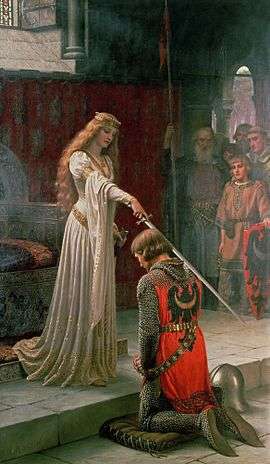The Accolade (painting)
 | |
| Artist | Edmund Leighton |
|---|---|
| Year | 1901 |
| Medium | Oil on canvas |
| Dimensions | 144 cm × 100 cm (57 in × 39 in) |
| Location | Private collection |
The Accolade is a painting by British artist Edmund Leighton. It is one of many paintings produced by Leighton in the 1900s on the subject of chivalry, with others including God Speed (1901) and The Dedication (1908). It has been described as among Leighton's best known works[1][2] and one of the most recognizable paintings of the period.[2]
Background
There are many stories considering the origin of and inspiration for the painting, although none of the them are confirmed. Historians agree that the painting depicts an accolade, a ceremony to confer knighthood. Such ceremonies took many forms, including the tapping of the flat side of a sword on the shoulders of a candidate or an embrace about the neck. In the first example, the "knight-elect" kneels in front of the monarch on a knighting-stool. The monarch lays the side of the sword's blade onto the accolade's right shoulder. The monarch then raises the sword gently just up over the apprentice's head and places it on his left shoulder. The newly appointed knight arises, and the administrator presents him with the insignia of their knightly order. In the painting, the ceremony is performed by a young queen, the knight bowed before her feet in a position of submission and fealty. An audience is gathered on the Queen's left, serving as witnesses to the ceremony. The painting does not depict the presence of a king. Based on the coat of arms and the flag, the nationality of the people in the picture seems to be Albanian .
Reception
All Art Classics describes Accolade as Leighton's best known work[1] and Kara Ross, Director of Operations for the Art Renewal Center, describes it as "the epitome of medieval iconography" and that, and as one of Leighton's most famous works, which "are among the most widely recognized paintings of the period."[2] Sotheby's catalogue describes it as one of "the most memorable" of his medieval subjects.[3] They also note that among this collection, "the two qualities which can always be found... are beautifully meticulous studied detail and a sensitive capturing of humanity."
References
- 1 2 ""The Accolade"". All Art Classics. Retrieved 18 July 2016.
- 1 2 3 Kara Ross. ""Edmund Blair Leighton"". Art Renewal Center. Retrieved 18 July 2016.
- ↑ ""A King and a Beggar Maid"". Sotheby's. Retrieved 18 July 2016.